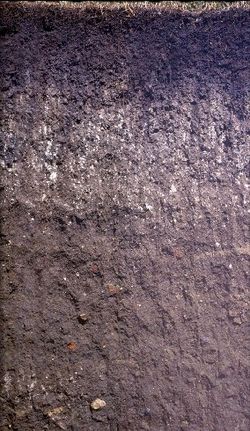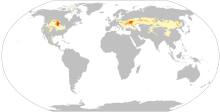Chernozem
| Chernozem | |
|---|---|
| Chernozemic soil | |
 | |
| Used in | WRB, other |
| WRB code | CH |
| Profile | AhBC |
| Parent material | Loess |
| Climate | Humid continental |
Chernozem (/ˈtʃɜːrnəzɛm/ CHUR-nə-zem),[a] also called black soil, regur soil or black cotton soil, is a black-colored soil containing a high percentage of humus[3] (4% to 16%) and high percentages of phosphorus and ammonia compounds.[4] Chernozem is very fertile soil and can produce high agricultural yields with its high moisture-storage capacity.[b] Chernozems are a Reference Soil Group of the World Reference Base for Soil Resources (WRB).
Distribution
[edit]
The name comes from the Russian terms for black (чёрный čjornyj) and soil, earth or land (земля zemlja).[2][3] The soil, rich in organic matter presenting a black color, was first identified by the Russian geologist Vasily Dokuchaev in 1883 in the tallgrass steppe or prairie of Eastern Ukraine and Western Russia.
Chernozem covers about 230 million hectares of land. There are two "chernozem belts" in the world. One is the Eurasian steppe that extends from eastern Croatia (Slavonia), along the Danube (northern Serbia, northern Bulgaria (Danubian Plain), southern and eastern Romania (Wallachian Plain and Moldavian Plain), and Moldova, to northeast Ukraine across the Central-Chernozem Strip of Central and Southern Russia into Siberia. The other stretches from the Canadian Prairies in Manitoba through the Great Plains of the United States as far south as Kansas.[5]
Chernozem layer thickness may vary widely, from several centimetres up to 1.5 metres (60 inches) in Ukraine,[6] as well as the Red River Valley region in the northern United States and Canada (location of the prehistoric Lake Agassiz).
The terrain can also be found in small quantities elsewhere (for example, in 1% of Poland, Hungary, and Texas). It also exists in Northeast China, near Harbin. The only true chernozem in Australia is located around Nimmitabel, some of the richest soils on the continent.[7]
Previously, there was a black market for the soil in Ukraine. The sale of agricultural land was illegal in Ukraine from 1992 to 2020,[8] but the soil, transported by truck, could be traded legally. According to the Kharkiv-based Green Front NGO, the black market for illegally acquired chernozem in Ukraine was projected to reach approximately US$900 million per year in 2011.[9]
Canadian and United States soil classification
[edit]Chernozemic soils are a soil type in the Canadian system of soil classification and the World Reference Base for Soil Resources (WRB).
Chernozemic soil type "equivalents", in the Canadian system, WRB, and U.S. Department of Agriculture soil taxonomy:
| Canadian | WRB | United States |
|---|---|---|
| Chernozemic | Kastanozem, Chernozem, Phaeozem | Mollisol |
| Brown Chernozem | Kastanozem (Aridic) | Aridic Mollisol subgroups (Xerolls and Ustolls) |
| Dark Brown Chernozem | Haplic Kastanozem | Typic Mollisol subgroups |
| Black Chernozem | Chernozem | Udic Mollisol subgroups |
| Dark Grey Chernozem | Greyzemic Phaeozem | Boralfic Mollisol subgroups, Albolls |
| Source: Pedosphere.com Archived 14 March 2016 at the Wayback Machine. |
Theories of Chernozem origin
[edit]- 1761: Johan Gottschalk Wallerius (plant decomposition)[10]
- 1763: Mikhail Lomonosov (plant and animal decomposition)[11]
- 1799: Peter Simon Pallas (reeds marsh)[citation needed]
- 1835: Charles Lyell (loess)[12]
- 1840: Sir Roderick Murchison (weathered from Jurassic marine shales)[12]
- 1850: Karl Eichwald (peat)[citation needed]
- 1851: А. Petzgold (swamps)
- 1852: Nikifor Borisyak (peat)[citation needed]
- 1853: Vangengeim von Qualen (silt from northern swamps)
- 1862: Rudolf Ludwig (bog on place of forests)[citation needed]
- 1866: Franz Josef Ruprecht (decomposed steppe grasses) [13]
- 1879: First chernozem papers translated from Russian[14]
- 1883: Vasily Dokuchaev published his book Russian Chernozem with a complete study of this soil in European Russia.[15]
- 1929: Otto Schlüter (man-made)[16]
- 1999: Michael W. I. Schmidt (neolithic biomass burning)[17][18]
As seen in the list above, the 19th and 20th-century discussions on the pedogenesis of Chernozem originally stemmed from climatic conditions from the early Holocene to roughly 5500 BC. However, no single paleo-climate reconstruction could accurately explain geochemical variations found in Chernozems throughout central Europe. Evidence of anthropomorphic origins of stable pyrogenic carbon in Chernozem led to improved formation theories.[16] Vegetation burning could explain Chernozem's high magnetic susceptibility,[19] the highest of the major soil types.[20] Soil magnetism increases when soil minerals goethite and ferrihydrite convert to maghemite on exposure to heat.[21] Temperatures sufficient to elevate maghemite on a landscape scale indicate the influence of fire. Given the rarity of such natural phenomena in the modern day, magnetic susceptibility in Chernozem likely relates to control of fire by early humans.[20]
Humification can darken soils (melanization) absent a pyrogenic carbon component. Given the symphony of pedogenic processes that contribute to the formation of dark earth, Chernozem summarizes different types of black soils with the same appearance but different formation histories.
See also
[edit]Notes
[edit]References
[edit]- IUSS Working Group WRB: World Reference Base for Soil Resources, fourth edition. International Union of Soil Sciences, Vienna 2022. ISBN 979-8-9862451-1-9 ([1]).
- ^ Russia Investment and Business Guide. International Business Publications. 2007. p. 63. ISBN 9781433041686. Retrieved 11 January 2018.[permanent dead link]
- ^ a b "chernozem | Etymology, origin and meaning of chernozem by etymonline". www.etymonline.com. Retrieved 5 October 2022.
- ^ a b "Chernozem". Merriam-Webster Online Dictionary. 2008. Retrieved 7 July 2008.
- ^ "How Chemical Pre-Treatments in Particle Size Analysis Impact Wind Erosion Modeling". AZoM.com. 28 July 2021. Retrieved 30 August 2022.
- ^ Ecology of Arable Land – Perspectives and Challenges by M. Clarholm and L. Bergström ISBN 978-94-010-6950-2
- ^ Ukraine: Soils in Encyclopædia Britannica
- ^ KG McQueen. "The Tertiary Geology And Geomorphology Of The Monaro: The Perspective In 1994" Centre For Australian Regolith Studies, Canberra 1994
- ^ "Ukraine lifts ban on sale of farmland in bid to receive international funds". Euronews. 31 March 2020.
- ^ Black market for rich black earth, Kyiv Post (9 November 2011)
- ^ Wallerius J. G. Agriculturae fundamenta chemica, åkerbrukets chemiska grunder. Upsaliae, 1761. 8, 4, 322 p.; The natural and chemical elements of agriculture. London, York: Bell, Etherington, 1770. 198 p.
- ^ 'Lomonosov M. V. § 125. // On the strata of the Earth: a translation of "O sloiakh zemnykh" (1763) / translated by S. M. Rowland, S. Korolev. Boulder: Geological Soc. of America, 2012. 41 p. (Special paper; 485) "And so, there is no doubt that black soil is not primordial matter, but that it has been produced by the decomposition of animal and plant bodies over time"
- ^ a b Geikie, A. (1875), Life of Sir Roderick I, Murchison, vol. 1, ASIN B0095632AU
- ^ Fedotova, Anastasia A. (August 2010), "The Origins of the Russian Chernozem Soil (Black Earth): Franz Joseph Ruprecht's 'Geo-Botanical Researches into the Chernozem' of 1866", Environment and History, 16 (3): 271–293, doi:10.3197/096734010x519762, JSTOR 20723789
- ^ Dokoutchaief B. Tchernozème (terre noire) de la Russie d'Europe. St.-Ptb.: Soc. Imp. libre économ., 1879. 66 p. (Comptes-rendus Soc. Imp. libre économ. T. 4).
- ^ Dokuchaev V. V. Russian Chernozem (1883) // Israel Program for Scientific Translations Ltd. (for USDA-NSF), S. Monson, Jerusalem, 1967. (Translated from Russian into English by N. Kaner)
- ^ a b Eckmeier, Eileen; Gerlach, Renate; Gehrt, Ernst; Schmidt, Michael W.I. (2007), "Pedogenesis of Chernozems in Central Europe—A review" (PDF), Geoderma, 139 (3–4): 288–299, Bibcode:2007Geode.139..288E, doi:10.1016/j.geoderma.2007.01.009, archived from the original (PDF) on 8 March 2016
- ^ Schmidt, M.W.I.; Skjemstad, J.O.; Jäger, C. (2002), "Carbon isotope geochemistry and nanomorphology of soil black carbon: Black chernozemic soils in central Europe originate from ancient biomass burning", Global Biogeochemical Cycles, 16 (4): 70–1–70–8, Bibcode:2002GBioC..16.1123S, doi:10.1029/2002GB001939, S2CID 56045817,
These data challenge the common paradigm that chernozems are zonal soils with climate, parent material and bioturbation dominating soil formation, and introduce fire as a novel, important factor in the formation of these soils
- ^ Eckmeier, E. (2007), Detecting prehistoric fire-based farming using biogeochemical markers (Dissertation), University of Zurich, Faculty of Science., doi:10.5167/uzh-3752,
It is now an open question as to whether Neolithic settlers did indeed prefer to grow crops where Chernozems occurred or if Neolithic burning formed the chernozemic soils.
- ^ Eckmeier, Eileen; Gerlach, Renate; Gehrt, Ernst; Schmidt, Michael W.I. (2007), "Pedogenesis of Chernozems in Central Europe—A review" (PDF), Geoderma, 139 (3–4): 288–299, Bibcode:2007Geode.139..288E, doi:10.1016/j.geoderma.2007.01.009, archived from the original (PDF) on 8 March 2016,
magnetic susceptibility of soil material may reflect past fires
- ^ a b Jordanova, Neli, ed. (2017). "Chapter 8 - The discriminating power of soil magnetism for the characterization of different soil types". Soil Magnetism. Academic Press. pp. 349–365. doi:10.1016/B978-0-12-809239-2.00008-5. ISBN 978-0-12-809239-2.
Chernozem soils exhibit similar features worldwide and are generally characterized by significant magnetic enhancement in the upper soil horizons.
- ^ Nørnberg, P.; Schwertmann, U.; Stanjek, H.; Andersen, T.; Gunnlaugsson, H.P. (2004). "Mineralogy of a burned soil compared with four anomalously red Quaternary deposits in Denmark". Clay Minerals. 39 (1): 85–98. Bibcode:2004ClMin..39...85N. doi:10.1180/0009855043910122. S2CID 129974901.
Further reading
[edit]- W. Zech, P. Schad, G. Hintermaier-Erhard: Soils of the World. Springer, Berlin 2022, Chapter 5.3.2. ISBN 978-3-540-30460-9
External links
[edit]- profile photos (with classification) WRB homepage
- IUSS profile photos (with classification) Archived 9 September 2018 at the Wayback Machine IUSS World of Soils
